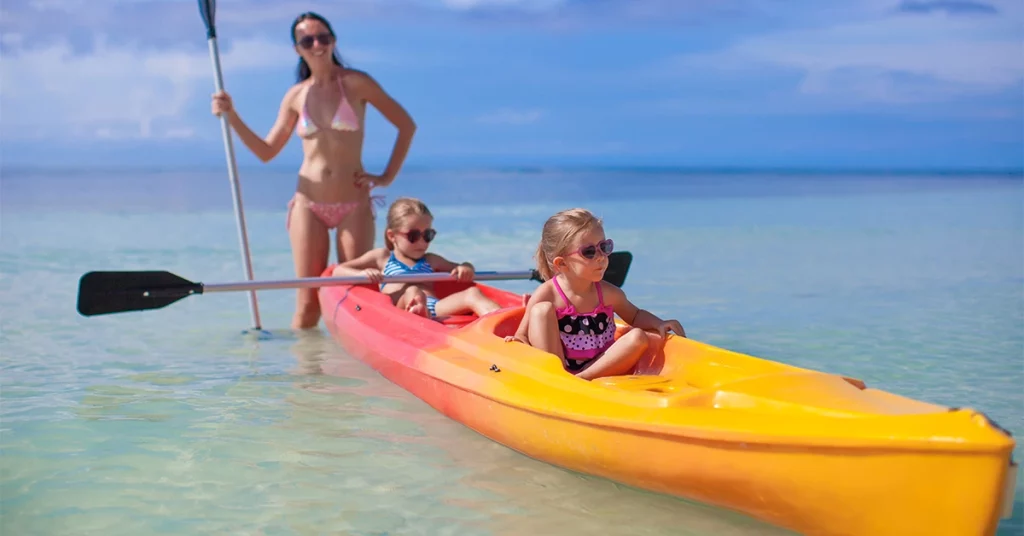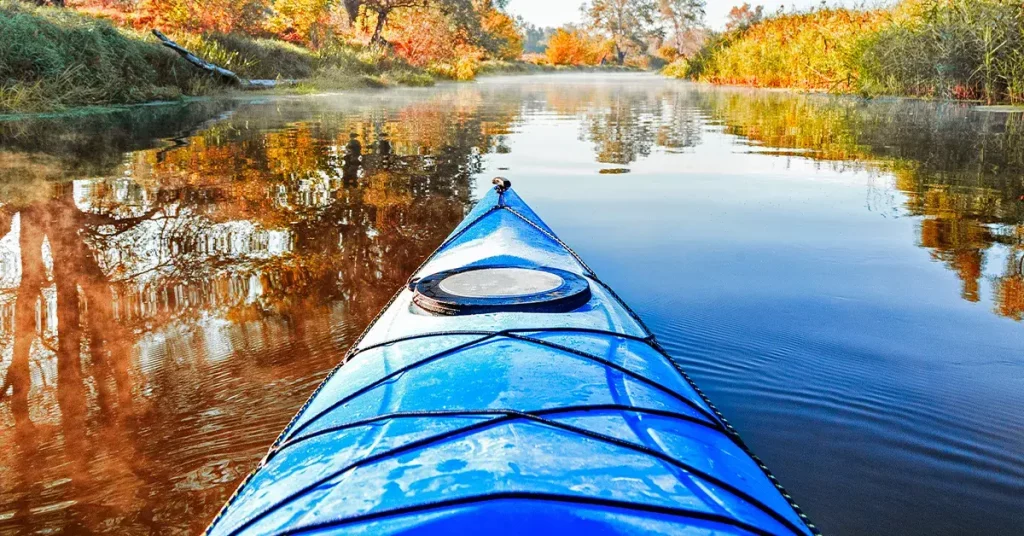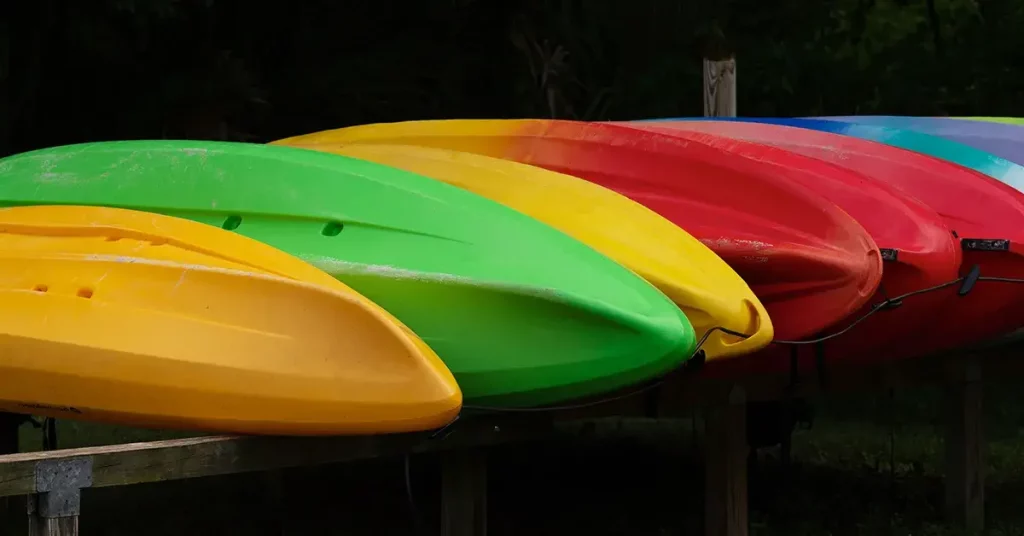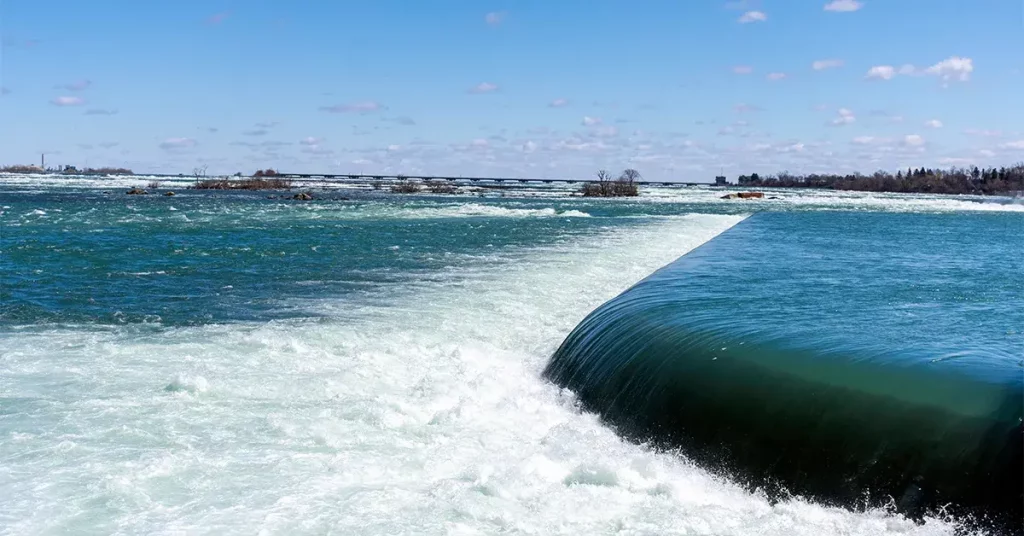Buying a kayak that’s too large or too tiny can be frustrating, as these vessels can be challenging to return (believe me, I know). That’s why we’ve created this kayak size chart to help you choose the right-sized kayak the first time around.
If you’ve been wondering what size kayak suits your lifestyle, preferences, and body, use this guide and kayak size chart to find out what size kayak best suits your needs!
How To Choose the Right Size Kayak
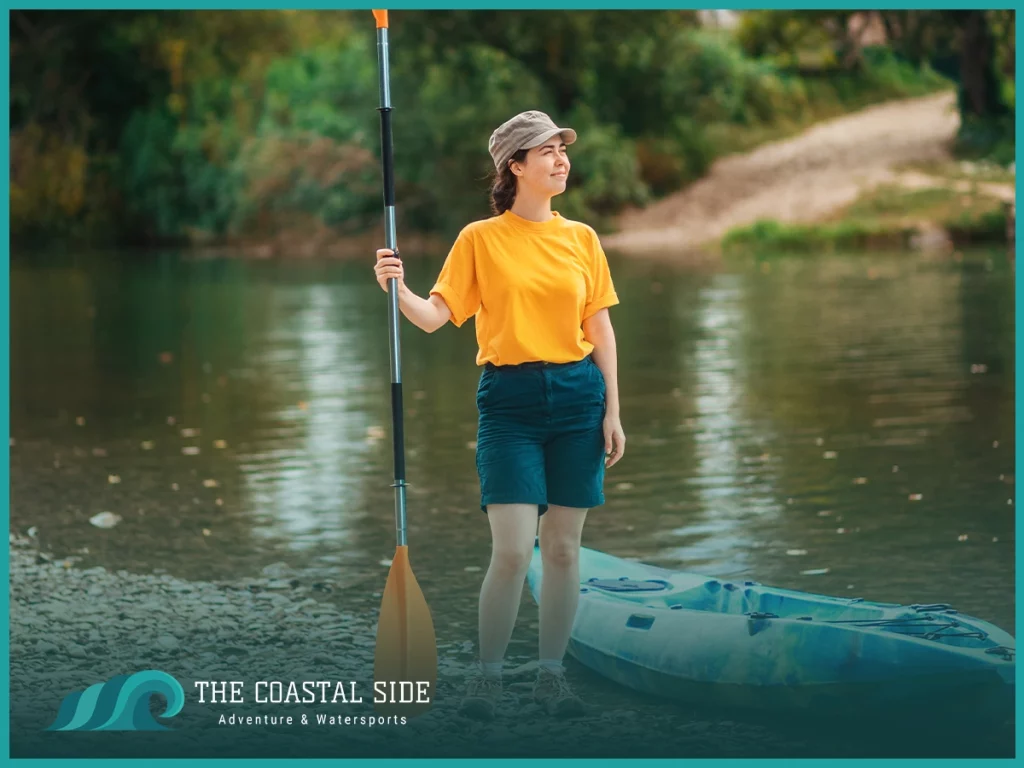
Have you wondered, “What size kayak do I need?” If so, know that you’re not alone!
Selecting a kayak that’s ideally suited to your body size can be challenging, especially if you’ve never purchased a kayak before. Fortunately, you can make it easier to choose the right-size kayak by:
- Considering the number of seats
- Thinking about weight capacity
- Imagining how you’ll use it
- Choosing an age-appropriate vessel
Consider the Number of Seats
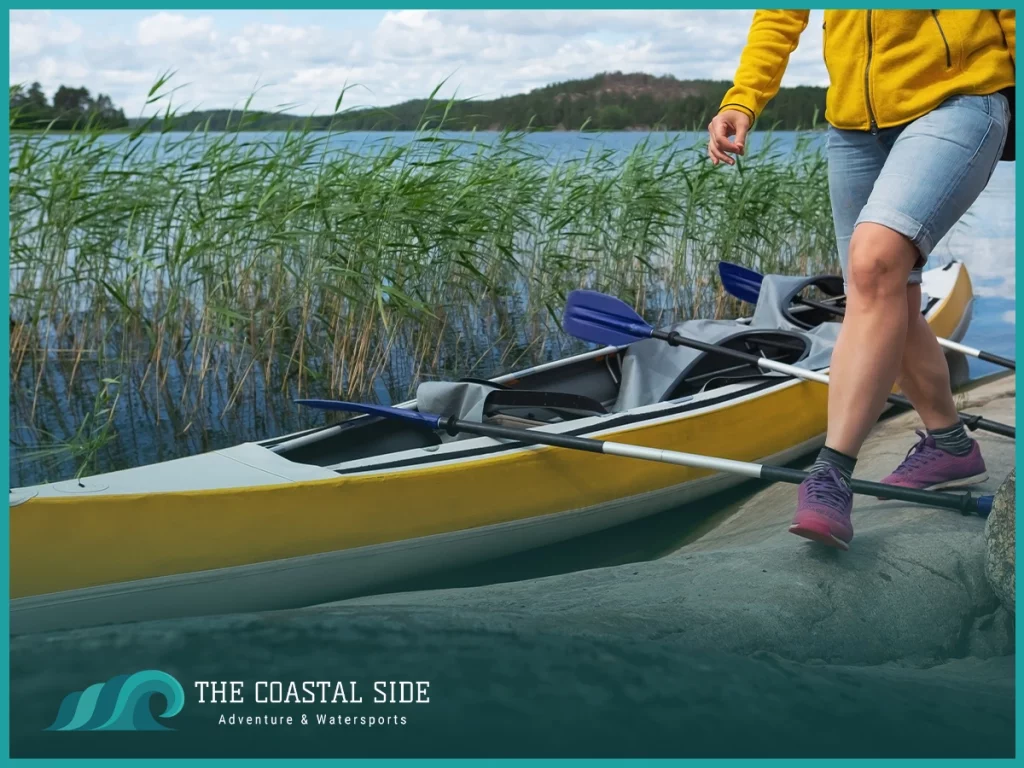
The first thing you’ll want to do when choosing a suitably-sized kayak is to consider the number of seats you’ll need. If you plan on kayaking alone, you’ll want to select a single-person kayak.
Alternatively, if you’re looking forward to kayaking with a partner, you might want to choose a two-person or three-person model.
Single Seat
Kayaks are similar to canoes, but they’re far lighter, have more shallow cabins, and are better suited to paddle solo.
For this reason, single-seat kayaks are some of the most common and popular types of kayaks.
Choosing the right kayak (scroll down for the kayak size chart) for yourself is relatively straightforward. You’ll want to follow these steps:
- Choose a kayak that suits your intended use (fishing, general paddling, etc.)
- Check that the maximum weight capacity is higher than your body weight
- Confirm that the kayak dimensions will pair with long kayaking trips
Double Seat
Tandem kayaks (two-person kayaks) have two seats, allowing two people to kayak together in one vessel. These kayaks are often used for recreation or fishing, though some touring kayaks are also designed for tandem use.
A tandem kayak is a longer kayak and ranges in length from 10ft to 16ft. The kayak’s weight capacity is between 400lbs to 600lbs. If you’d like to enjoy some kayaking with a partner, family member, or friend, you’ll likely want to choose a tandem kayak.
Triple Seat
Three-person kayaks are far rarer than single-person kayaks and tandem kayaks. That’s because balancing the weight of three individuals in a kayak can be tricky. Canoes are better at handling multiple people.
Think About Weight Limits
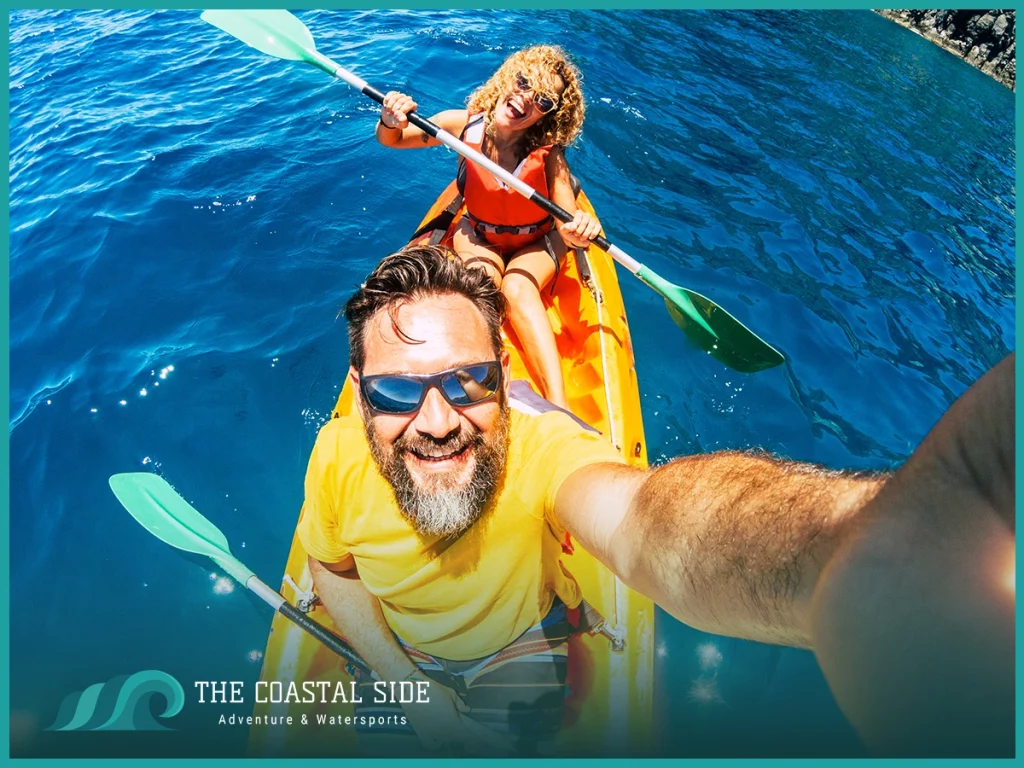
After selecting the number of seats for your ideal kayak, it’s time to consider kayak weight limits. Every kayak has a specific weight capacity, and when users go over this limit, the kayak can sink.
If you are shopping for a one-person kayak, you can compare your weight to the maximum weight capacity of your top picks. Doing so is an excellent way to narrow down your selection and ensure you’re choosing the optimal kayak size for you.
A tandem kayak, or three-person kayak, can be more challenging to select, as you might not know your partner’s weight. If you’re shopping for a multi-person kayak, it’s almost always best to choose a vessel with an above-average weight limit of 500lbs or more.
Imagine How You’ll Use It
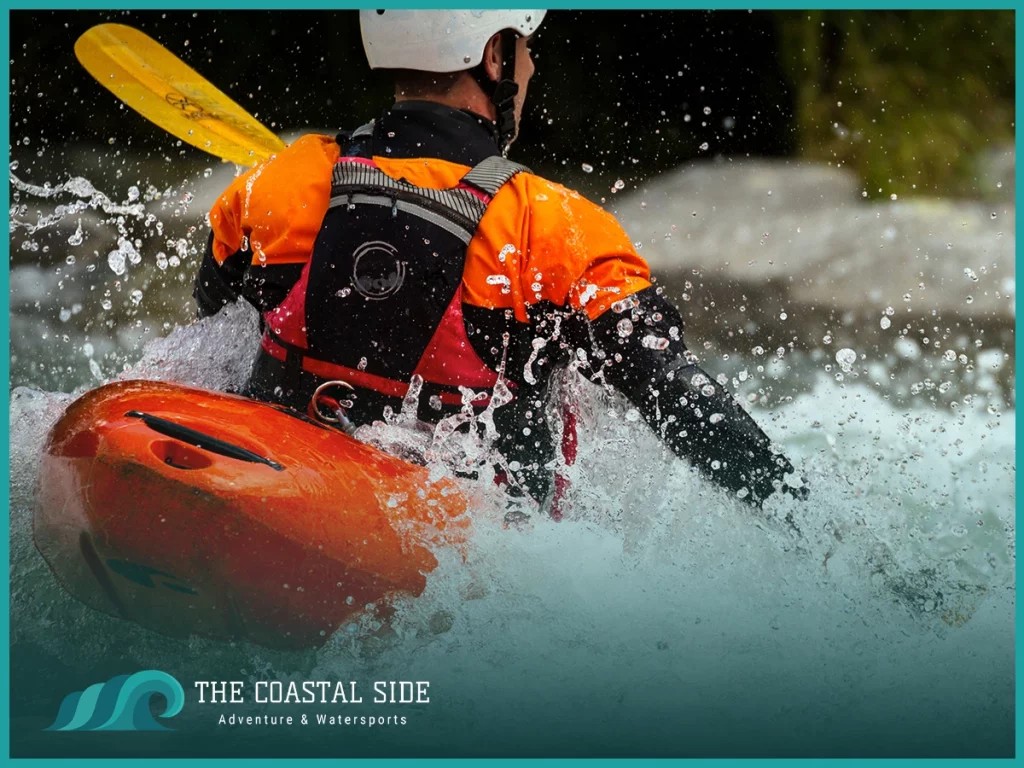
Did you know that type of kayak and size are closely related? After all, some designs are better suited for specific activities.
For example, those looking to enjoy peaceful kayaking on a tranquil afternoon might prefer to use a recreational kayak. But those who plan on navigating rapids will probably want to opt for a touring kayak.
Generally, all kayaks fall into one of the following categories:
- Recreational kayak
- Fishing kayak
- Touring kayak
We’ll address how each kayak’s size differs and what that means for users.
Recreational Kayak
Recreational kayaks are some of the most popular kayaks, as they’re intended for general use. Notably, most recreational kayaks are very affordable options, making them an excellent choice for beginner-level kayakers.
There are three types of recreational kayaks:
- Sit-on-top Kayak
- Standing Kayak
- Sit-in Kayak
The best choice for you depends on your intended use and personal preferences. Let’s explore each option to find out which might be the right choice for you.
Sit-on-top Kayak
A sit-on-top kayak is essentially a contoured raft with tapered ends. It is a low volume kayak that doesn’t offer much separation from the surrounding water.
Sit-on-top kayaks are a fantastic choice for recreational kayakers. They work well along shallow rivers and calm lakes and streams. However, these kayaks don’t tend to support a lot of weight.
Standing Kayak
Standing kayaks are great for lightweight users who have excellent balance. However, they can be challenging for big and tall kayakers to use, making them best suited to younger, smaller users.
Sit-In Kayak
Sit-in kayaks feature an enclosed cockpit that houses the legs and lower body. This is one of the most common types of kayak.
Most single-person recreational kayaks, sea kayaks, and whitewater kayaks are sit-in kayaks. The design of these vessels also allows them to support more weight than standing or sit-on-top kayaks, which is a plus for tall kayakers.
Fishing Kayak
While you could go fishing in a canoe, kayak fishing could be just as fulfilling, if not more so! Anglers who prefer to fish alone may enjoy fishing kayaks much more than canoes.
Fishing kayaks are some of the longer kayaks available. Most fishing kayaks are 12 to 16ft long, with above-average weight limits of 400lbs or more.
These features allow users to navigate many different types of water and tote plenty of fishing gear along for the ride.
Touring Kayak
Touring kayaks can be long and slender or short and stout. Either way, these vessels are designed for long-term durability.
Touring kayaks fall into one of two sub-categories:
- Whitewater Kayak
- Ocean Kayak
As you might imagine, whitewater kayaks are often the most durable touring kayaks. That said, ocean kayaks can be just as strong and resistant to damage, but they’re much longer and slimmer than oval-like whitewater kayaks.
Whitewater Kayak
Speeding down whitewater rapids in a kayak can be a thrilling experience. But these kayaks need to be lighter and more durable than recreational kayaks to facilitate the kayak’s stability.
The best whitewater kayaks are shorter types of kayaks, with many falling between 6ft and 10ft in length. This more compact design makes whitewater kayaks easier to control and maneuver in rough whitewater rivers.
Ocean Kayak
Ocean kayaks (also called a sea kayak) are designed to withstand harsh saltwater and rough waves. They’re also designed to remain agile and easy to navigate when traveling along shallow shorelines.
If you plan on traversing ocean waters in a sea kayak, you’ll likely want to choose a sit-in ocean kayak. This size kayak is best suited for adults, and they typically vary in size between 12 and 16ft.
Choose an Age-Appropriate Vessel
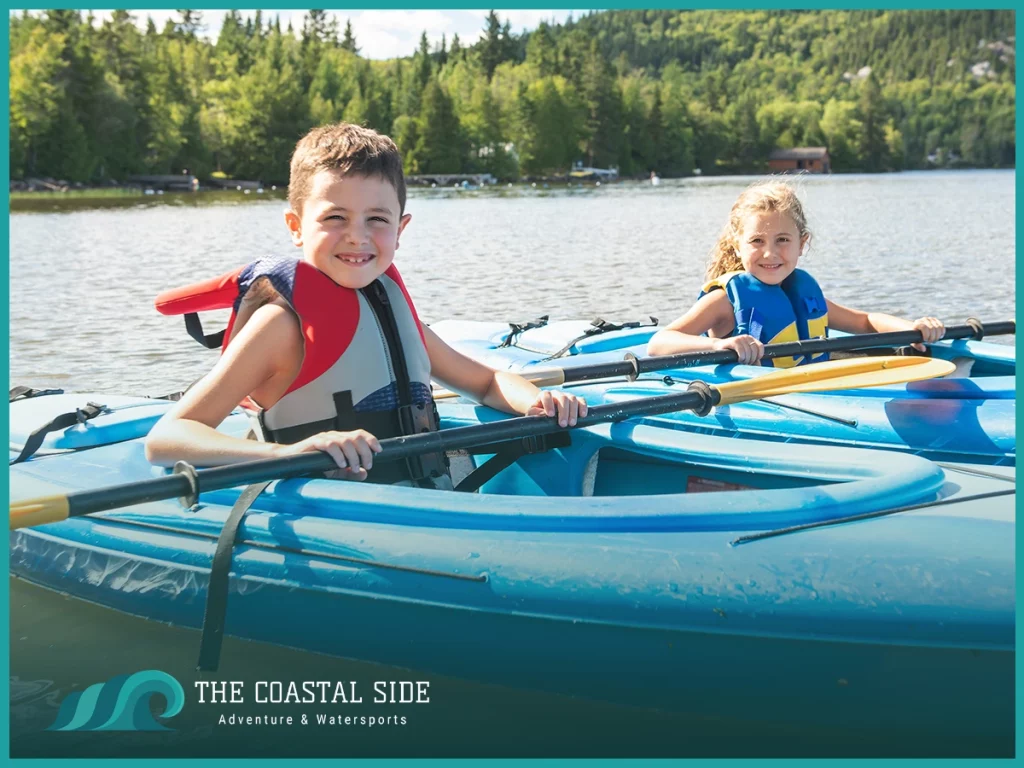
Choosing a kayak based on age will also help you select the right kayak. Still, you’ll need to understand age-based body size ranges to take full advantage of this option.
Kayaks for Kids
Kayaks for kids should be short, lightweight, and easy to navigate. An inflatable kayak or sit-in kayaks are often some of the best options.
Kid-friendly options are shorter kayaks and have an upper weight limit of 130lbs.
Kayaks for Teens
Buying a kayak for a teen can be tricky, but it’s often best to choose a kayak that’s between 7ft and 12ft. You’ll also want to choose a kayak with a maximum weight that’s between 50lbs and 100lbs greater than your teen.
Consider your teen’s intended use (recreation, whitewater kayaking) before you buy to ensure you’re selecting a kayak that appeals to their needs.
Kayaks for Adults
Adult-friendly kayaks come in almost every size and style. There are single-person recreational kayaks, tandem sea kayaks, and three-person fishing kayaks available for adults.
Kayaks for Couples
Kayaks for couples, aka tandem kayaks, should be between 10ft and 16ft long, with a maximum weight limit of at least 400lbs.
Naturally, it’s an excellent idea to add your body weight to your partner’s to ensure you select the kayak dimensions that can support you both.
Also, factor in your kayak width. Some kayaks can be quite thin, and that might prove uncomfortable for couples. Height is also critical, as both couples should feel comfortable when sitting in the kayak.
If possible, visit a local sporting goods store with your partner and try sitting in various-sized kayaks. After all, it’s hard to tell if a kayak’s chairs are comfy when you’re browsing pictures of them online!
Kayak Size Chart
Are you hoping to streamline the kayak buying process? You can easily find the right-sized kayak by reviewing the kayak size chart below!
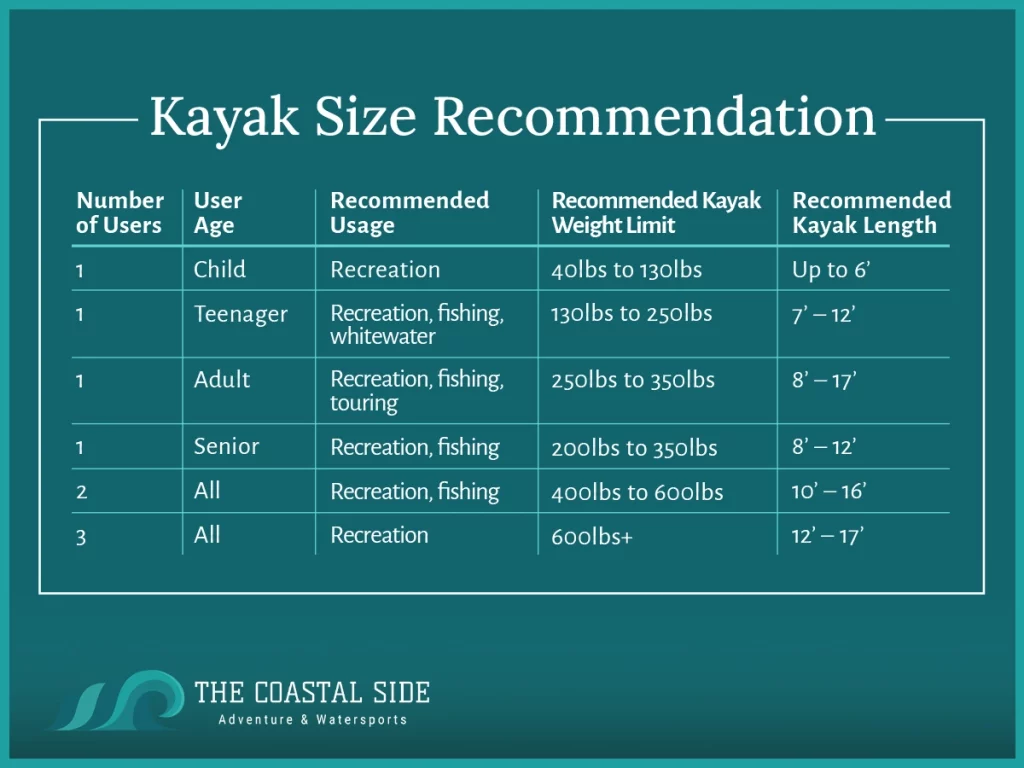
Final Thoughts
You don’t need to tackle complex algebra equations to find the correct size kayak. By following the tips in this guide and referencing the included chart, you can select the perfect kayak for your needs!

